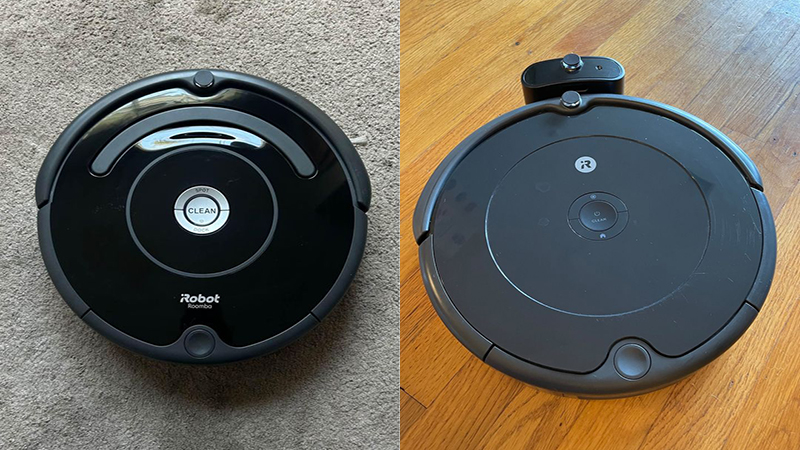When it comes to robot vacuums, the wide variety of options can be overwhelming. This is particularly true of iRobot, a brand that offers a range of Roomba models to fit different budgets and needs. In this article, I’ll closely examine two of iRobot’s entry-level models: the Roomba 675 vs 694; which one truly offers the best bang for your buck?
After my own tests, it came out that the winner was the Roomba 675. While both models share many similar features, the 675 still outshines with its cleaning performance. This model seems to clean faster and more thoroughly.
The Roomba 694 has its own set of advantages that could make it a suitable option for certain users. Read on to uncover the specific strengths and weaknesses of each model and learn why the Roomba 675 claims the top spot in this face-off.
Roomba 675 vs 694: Comparison Chart




Roomba 675 vs 694: Differences
After weighing the differences between these two Roomba models, I conclude that the Roomba 675 wins 2:0 and ties 2 against the Roomba 694. Although both of them share many similar features and designs, the Roomba 675 still stands out due to its cleaning performance and quiet operation. Read the breakdown below to learn more details.
Cleaning Performance
The winner: Roomba 675
Performance on multi-surface
In my tests, both devices performed equally well on bare floors and carpets. For comparison, the Roomba 675 performs slightly better than its opponent. Although both machines move randomly based on their sensors, the Roomba 675 cleans more thoroughly and misses fewer areas.
On bare floors, these two machines deal best with light particles such as cereal crumbs, oats, flour, and rice. They will take a few more passes than usual when picking up heavier debris like sand. They also struggle with Froot Loops and find it nearly impossible to pick up larger pieces like popcorn.
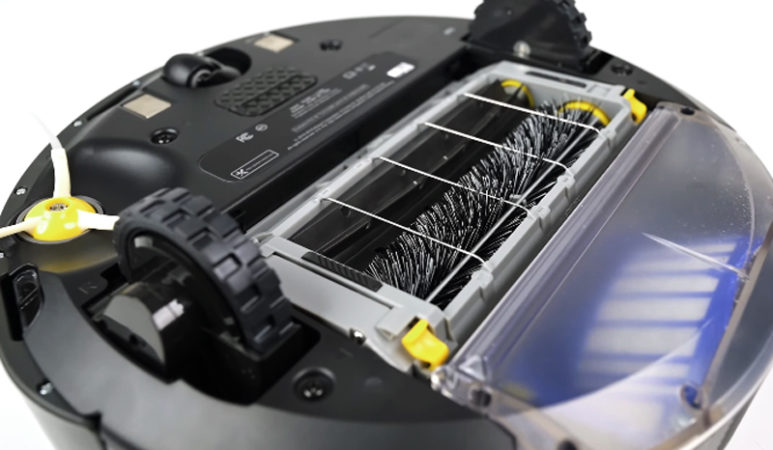
When talking about their performance on carpeting, I consider them quite suitable for vacuuming low-pile carpets. They are not ideal for high-pile carpets, as they only clean surface debris and not deep under the carpet.
In my opinion, the main reason these machines struggle with heavy debris and deep-clean carpets is because they don’t have a lot of airflow. As I measured, their airflow is 9 CFM, which is a bit lower than average.
The plus point is that these machines can transition smoothly from hardwood floors to carpets. Their wheels have the ability to self-adjust their height, helping the device move easily on rough terrain. Besides, each machine is equipped with a cliff sensor, which allows the device to detect edges or cliffs, such as stairs or ledges, in order to prevent the vacuum from falling off and potentially getting damaged.
Additionally, these machines also come with a side brush for cleaning edges effectively. Sometimes, these brushes work a bit aggressively and scatter the piles of debris.
Pet hair performance
In my experience, I’ve found that both the Roomba 675 and 694 struggle with pet hair on all surfaces. Don’t get me wrong; these machines actually still do a decent job of picking it up. Their dual brush roll works well with both pet hair and large particles.
The rollers of these Roomba models are advertised as self-cleaning, but they can still get tangled easily, especially if someone in your family has long hair. If this is the case, I recommend purchasing the Roomba cleaning tools kit to effectively deal with the hair that gets wrapped around the brushes.
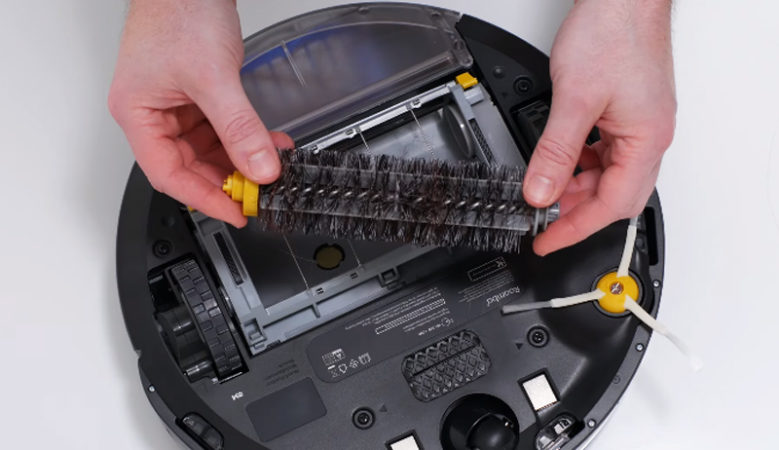
Design & Usability
The winner: Roomba 675
Build quality
Both models are designed to withstand the wear and tear that comes with regular home use. They are primarily made of high-quality plastics that can endure collisions with furniture and walls, which is a common occurrence during operation. While they may not have the same level of durability as pricier models, they are still built to iRobot’s high standards and reputation in the industry.
The Roombas also feature rubberized wheels to better navigate different types of flooring, including hardwood and carpet. The bristles and brushes are generally made from durable materials designed to effectively pick up dirt and debris over a long period of time. These parts are also replaceable, allowing you to maintain the performance of the machine over time.
Dimensions and weight
The Roomba 675 measures roughly 13.4 inches in diameter, stands at approximately 3.54 inches tall and weighs about 6.77 pounds. These dimensions allow it to easily navigate under furniture and through narrow spaces while also being lightweight. Its weight makes it effortless to move between rooms or floors as needed.
Likewise, the Roomba 694 has similar dimensions and weight as the 675. Its compact design enables it to move smoothly through tight spaces and corners, making it highly manoeuvrable. This design is specifically tailored to meet the needs of a typical household, striking a balance between cleaning coverage and the ability to navigate around obstacles.
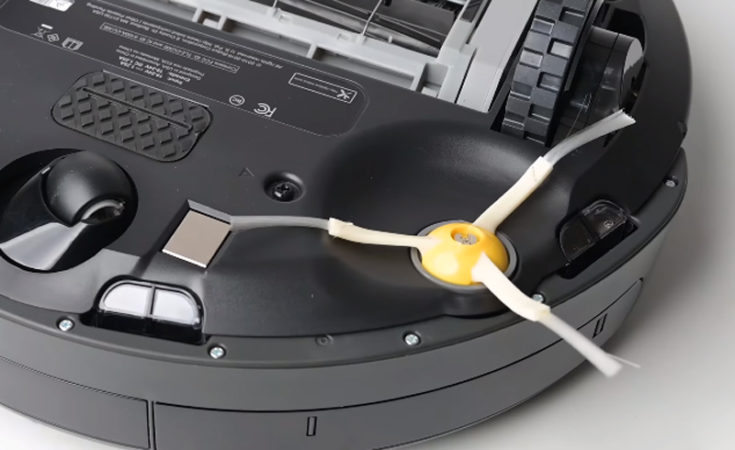
Both models are relatively easy to store when not in use due to their similar compact sizes. They can be tucked away in a corner or even placed on a charging dock without taking up too much space.
Battery and charging
Both the Roomba 675 and Roomba 694 are equipped with Lithium-ion batteries, which have become the industry standard for their energy density and longevity. These models offer a runtime of up to 90 minutes on a full charge. While a 90-minute runtime may not stand out as exceptional, it does fall within the average range for robotic vacuums in this price bracket.
The Roombas come equipped with a smart charging system that automatically sends them back to their charging station when the battery is low. This feature eliminates the need for manual intervention, making it easy and smooth to clean without interruption. The device can quickly resume cleaning, if necessary, with a recharge time of only about 2 hours to complete the job.
Besides, these two devices also come equipped with a battery indicator light, providing a visual cue that informs you when it’s time for the device to recharge. This straightforward indicator enhances the user experience by keeping you informed about the machine’s status without the need to consult the app or dig through menus.
Noise
In the noise level test, I found that both machines had a fluctuation between 62 and 65 dB. However, the Roomba 675 was slightly quieter, particularly on low-pile carpets.
I have found that these robot vacuums produce a low-volume sound that does not overpower other noises like television or conversations. It is also quiet enough that you need not worry about waking up pets or children. Personally, I find the noise level to be tolerable, as I usually listen to audiobooks or use earbuds when indoors.
Navigation
The navigation in both models relies primarily on adaptive algorithms and a variety of sensors, including cliff detectors, to navigate your home. These models move in a random pattern, covering the floor area multiple times to ensure thorough cleaning. While the navigation may appear random, it is still designed to cover the entire floor. But, to be honest, this approach may be less efficient than the systematic navigation found in more expensive models.
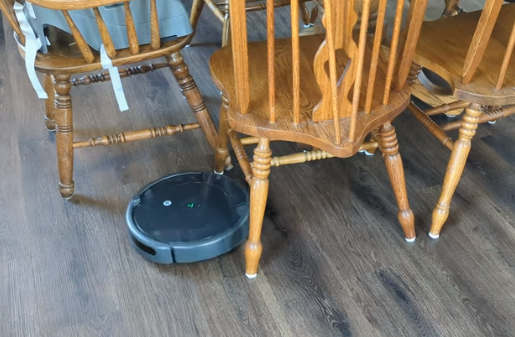
Thanks to the dirt detection technology, both devices are quite proficient at detecting dirtier areas in your house and cleaning those areas more thoroughly. They can also detect stairs and other drops due to their cliff sensors, preventing tumbles that could damage the machine.
When they encounter an obstacle, they will either turn and go in a different direction or follow along the edges, depending on the situation. In addition, both sides of each machine have bumpers that sense when the device runs into walls, preventing collisions.
Control
Tie
I don’t find any significant difference between the two in terms of ease of operation. Both are designed to be user-friendly, offering multiple options for control to suit different user preferences. You can control both models via the iRobot Home App since they are both Wi-Fi enabled.
By using the app, you can easily start, stop, and schedule cleaning sessions, view your cleaning history, and receive notifications. This feature provides a great deal of control and customization, making it perfect for users who prefer to manage their Roomba from a distance.
Moreover, these devices can be integrated with home assistants like Amazon Alexa and Google Assistant for voice control. You can give voice commands to stop or start cleaning, return the Roomba to its dock, and more.
Besides, each model also comes with physical buttons on the device itself for manual control. On their faceplate, you can see a few buttons for power, spot cleaning, and docking, as well as wifi and battery indicators.
Cleaning & Maintenance
Tie
These entry-level models typically come with a standard-sized dustbin, about 300 ml, that is adequate for small to medium-sized homes. The dustbin is generally easy to remove, empty, and clean, which makes for a user-friendly experience.
In terms of filtration, both models come equipped with a basic filtration system designed to capture larger particles, dust, and pet hair. Their filters are located inside the dustbin. I can’t find any information that makes sure these devices include HEPA filters. Therefore, if you are seeking a machine that is ideal for households with members who have severe allergies or asthma, you should consider it.
The manufacturer recommends emptying and cleaning the dustbin after every use and cleaning the filter every two months. However, the cleaning period is still based on your frequency of usage.
Besides cleaning and maintaining the dirt bin and filtration, you also need to periodically clean a number of other parts of the machine, including the main brushes, the side brushes, the frit caster wheel, the cliff sensors, and the charging contact. These tasks are all quite simple and do not take much time, so make sure you do them periodically to extend the lifespan of your machine.
Quick Rundown Of Roomba 675
- Capacity volume - .6 liter. Works with Alexa for voice control (Alexa device sold separately)
- Clean and schedule from anywhere with the iRobot HOME App; compatible with Amazon Alexa and the Google Assistant
- Patented 3-Stage Cleaning System and Dual Multi-Surface Brushes pick up everything from small particles to large debris
- Full suite of intelligent sensors guide the robot under and around furniture to help thoroughly clean your floors
- Auto-Adjust Cleaning Head automatically adapts its height to effectively clean carpets and hard floors
Quick Rundown Of Roomba 694
- Design: Sleek, premium design complements your home decor; The Roomba 694 is a great way to begin cleaning your home smarter. Just schedule it to clean up daily dirt, dust, and debris with the iRobot Home app or your voice assistant. - for effortlessly clean floors
- Auto-Adjust Cleaning Head: Auto-Adjust Cleaning Head automatically adapts its height to effectively clean carpets and hard floors
- Adaptive Navigation: A full suite of advanced sensors allows Roomba to navigate under and around furniture, and along edges. Cliff Detect keeps it from falling downstairs
- Clean Floors Every Day: The Roomba 694 provides a system of cleaning features and smart sensors that allow the robot to adjust to your unique home and deliver a daily clean
- Automatically Recharges: The Robot Vacuum runs for up to 90 minutes before automatically docking and recharging
Product videos
Related Articles to Roomba 675
Related Articles to Roomba 694
- Roomba 692 vs 694: 2 Of The Best iRobot’s Budget-friendly Robot Vacuums
- Roomba E6 Vs 694: Is There Any Upgrade In iRobot Entry-Level Robot Vacuums?
- Roomba 694 Vs 960: The Pros And Cons – Which Is Better?
- Roomba 690 Vs 694: Compare Two Budget-Friendly Robot Vacs – Are They Different?
- Roomba 694 vs i1: Detailed Comparison – Are There Any Differences?
- Roomba 691 Vs 694: Are There Any Differences?
References:
- Roomba 675: https://www.irobot.com/en_US/roomba-vacuuming/robot-vacuum-irobot-roomba-675/R675020.html
- Roomba 694: https://www.irobot.com/en_US/roomba-vacuuming-robot-vacuum-irobot-roomba-69-4020/R694020.html

Richard B. Schmidt is a prominent figure in the vacuum cleaner industry, boasting over 15 years of expertise. Armed with a Robotics Engineering degree from Northeastern University and a Master’s in Consumer Science from Harvard, his unique blend of technical knowledge and consumer insights positions him as a sought-after authority in vacuum cleaner evaluation. Richard’s career began at Dyson, where he contributed to the development of innovative vacuum models. Transitioning to advocacy and reviews, he co-founded the first Vacuum-focused blog in 2008, offering comprehensive analysis and user guides for various vacuum cleaners. In 2020, he founded RoboMop.net, providing ongoing insights through columns and buyer’s guides.
